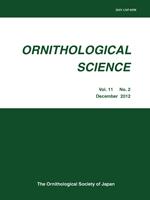Carbon and nitrogen stable-isotope ratios were measured in the egg yolks of four species of seabirds in Teuri Island and Rishiri Island, Japan. Delta 15N of the yolks of Rhinoceros Auklets Cerorhinca monocerata (11.2– 12.3‰) and Black-tailed Gulls Larus crassirostris (11.3 –12.5‰) were lower than those of Slaty-backed Gulls Larus schistisagus (13.4–14.2‰) and Japanese Cormorants Phalacrocorax capillatus (14.0–16.2‰); suggesting that the former two species foraged mainly on low trophic level small fishes and sometimes on krill, while the latter two species fed on higher trophic level prey and larger fishes.
How to translate text using browser tools
1 December 2012
Prey Resources used for Producing Egg Yolks in Four Species of Seabirds: Insight from Stable-Isotope Ratios
Motohiro Ito,
Kentaro Kazama,
Yasuaki Niizuma,
Hiroshi Minami,
Yuzan Tanaka,
Yutaka Watanuki
ACCESS THE FULL ARTICLE

Ornithological Science
Vol. 11 • No. 2
December 2012
Vol. 11 • No. 2
December 2012
diet
egg formation
Egg yolk
seabirds
Stable-isotope ratio




